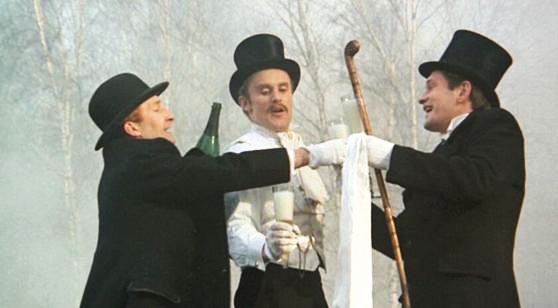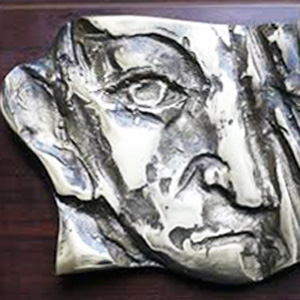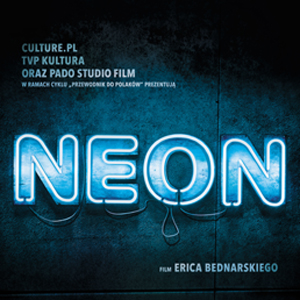
Polish Movie Nite was a mini-series of free public events held at The Polish Club in San Francisco in 2010-11. Conceived by Maureen Mroczek Morris and myself, Joanna Szupinska, during our participation in the 2010 iteration of Poland in the Rockies, PMN aimed to promote Polish culture to broad Bay Area artistic and scholarly communities through intimate screenings. About once a month, I invited local academics and practitioners working in the arts to present movies to their friends and colleagues. Speakers chose both fiction and documentary films that compelled them for personal or professional reasons, while the Polishness of those choices was often incidental to that initial interest. Through their investment of research and reflection, speakers often came away with a newfound appreciation for Polish culture and history, and a better understanding of the complexities of contemporary Poland.
For the final event in May 2011, art historian Julian Myers and curator Chris Fitzpatrick presented Andrzej Wajda’s “The Promised Land” (1975) by reflecting on the PMN series as a whole, and asking difficult questions about the notion of a national cinema. Their discussion follows below, and will be followed by other texts produced for the PMN series in the coming issues of CR.
– JSz
Chris Fitzpatrick: Thanks to Joanna Szupinska and Maureen Mroczek Morris. Over the course of this series, we’ve enjoyed a diverse range of films in the unique site of the Polish Club, which has, since the 1920s, fostered community activity and exchange. Surely that community has grown as a result. Since August of last year, we’ve viewed and heard the story of the Berlin wall, told through the perspective of rabbits. We’ve witnessed strange and protracted documentation of Tadeusz Kantor’s avant-garde theatre. And we’ve watched a marriage dissolve through a woman who fucks an octopus. We’ve also been given an opportunity to think about a rich culture outside the usual stops of London or Paris, Rome, or New York. In other words, by creating this series, Joanna introduced a new set of issues and concerns into the conversation, as told through the voices of the presenters and filmmakers alike.
Tonight we will be presenting Andrzej Wajda’s “The Promised Land” (1975), a film adapted from Władysław Reymont’s 1898 novel. It is a story told through lush scenery, where pastoral and industrial settings come to seem somehow equally sublime, and through complex narrative. It is a film grounded authentically, if ambiguously, in history – a history marked by the social and physical effects of industrialization, exploitation, and revolution. Indeed the film was shot in surviving period factories and urban landscapes of Łódź and Silesia. Wajda has recalled finding in one textile factory equipment marked “Manchester 1884” – connecting this machinery to industrialism’s “ground zero” as it were. Written by Wojciech Kilar, the unusual score mimics the percussive clanging of this machinery, locating it at the heart of the film’s narrative.
“Ziemia obiecana” was Łódź’s nickname, given by immigrants arriving in the burgeoning industrial center, searching for the prosperity promised by rapid modernization. Reymont and Wajda appropriate the nickname with a rich sense of irony. The decisive action of the film begins when three dispossessed but industrious men – a Polish noble, a Jew, and the German son of a factory owner – set out to build their own factory, a textile manufacturing center. As one of them says, “I have nothing, you have nothing, he has nothing: this means we have enough to start a factory.” This was the “promise” of the title: the idea that the novel abstraction of money and profit might offer up some escape from family history and traditional village life. As we’ll see, this dream is quickly corrupted by the principals’ greed and misbehavior, leading to something like a hell on earth.
Julian Myers: This being the last Polish Movie Nite I want to bring up the very idea of a national cinema, and Wajda’s place in a Polish national cinema. The idea of a “national cinema” is hard to extricate from the very idea of a “national character,” and everything it entails. It is essentially a political category, about which there are many debates. But the idea of being a Polish filmmaker is one that Wajda embraced. As cinema historian Thomas Elsaesser relates in his book European Cinema, “Andrzej Wajda was Polish cinema from the late 1940s into the 1960s and up to ‘Man of Marble’ in 1977.” He makes films that teach national history, films to be viewed by every Polish schoolchild. We could compare him to a figure like Steven Spielberg, who is, in fact, a strong advocate of Wajda’s work. And you see why: like “Amistad” (1997) or “Schindler’s List” (1993), Wajda’s films are sweeping historical epics that seem to tell us something true or truly historical. Released in 1975, “The Promised Land” looks like a moralistic history lesson for a national audience. In a very direct way this film means to teach a lesson about capitalism and industrialization, from a Polish perspective. They’re evil.
But look closer and this lesson comes to seem much more ambiguous. Morally, politically, and, I think, aesthetically. Perhaps this ambiguity comes from the fact that this is a “national” lesson for a “nation” that doesn’t exist. At the time of Reymont’s novel, Poland was partitioned amongst its neighbors, who, after the failed January Uprising in 1864, aimed to suppress Polish culture, language, and so on. Wajda’s film, too, was made in the early to mid 1970s, while Poland was dominated by the Soviet Union. In the 70s, Poland had an official “state” culture, but a national cinema is a peculiar thing in a condition of domination. Elsaesser points out a further ambiguity as well. What appeared to outsiders in the 1970s as a “national cinema,” “may well have struck Polish critics and audiences not as national cinema but as state cinema: official, sanctioned, sponsored.” So “The Promised Land” is an artifact of a “national cinema” that may be without a “national audience” as such (except as it appeared to others, elsewhere). It wants to invent a national audience, but on what terms?
CF: This might explain some of the film’s strange “lessons,” which evince something more than the usual sleight-of-hand to circumnavigate censorship. The moral universe is chaotic. Characters commit crimes and don’t suffer; others, who have done nothing wrong, do. The main character, Karol, is a cold and heartless sociopath – the logical outcome (the film argues) of his new position as factory director, then factory owner. “Your humanity is not required at the factory,” he says early on to one of his workers. But while tragedy comes, he learns nothing from it. Given the chance to change his ways, he doesn’t.
JDM: What’s interesting to me is that “The Promised Land” pretty much has no hero, no “good,” except in negative form: the unmarked landscape, authentic social life, agriculture, the past, all those things capitalist industry transforms. “The good, wholesome, healthy village life” – this is how Joanna Szupinska put it, in conversation with us – is now hopelessly transformed into the proletarian mass.
CF: If we think about the meaning of the title “The Promised Land” in terms of a specific, delimited, geographical place, then the irony of the title becomes clear. A factory disrupts that “land.” It makes Łódź, in this case, not a fixed place, but a terminal for importing material, processing it, sending it out – thereby overwriting or erasing the landscape itself. Factories such as those we see in the film or, by extension, industrialization itself, focus well beyond the peripheries of the space they occupy, on external markets. A factory eats away at its local resources, which in this case would be the people, the workers. This is seen literally and figuratively throughout the film: people are actually eaten by these machines.
JDM: The very word “factory,” synonymous with industrial progress, points to this radical reorganization of people, places, and things. Preceding Manchester by a century or more, the word came from the Portuguese feitoria, meaning “trading post.” To quote Susan Buck-Morss, “Factories [for the Portuguese] were trading companies in foreign countries or colonies, granted monopolies by royal charter, who sent agents, or ‘factors,’ to these foreign outposts that functioned as company headquarters, storehouses, and wholesale processing centers. They initiated the modern form of corporations, amassing capital through the joint-stock system (prohibited as too speculative for domestic manufacture) that financed the risky business of long distance ‘trade,’ a euphemism for the extraction of value overseas. Factories were agents of imperial projects, sharing real estate with forts and integrally involved in colonial wars. And they were enormously profitable, with no sense of what constituted a ‘fair’ gain… It is not misleading to understand the first factories of Manchester as an extension of the colonial system, which was now invading the mother country.” And we can extend this conclusion to the textile factories of Łódź as well, with their Manchester gear. A foreign system sucking blood from the “mother country,” the factory wreaks havoc on the life of its “national” host.
CF: I called Karol the “main character” of this film earlier, but at this point, it seems clear that Łódź and its factories are the “main characters,” so to speak; and this is echoed through the score. The three principals serve as something like class-national types (the disenfranchised Polish nobleman, the German bourgeois, and the Jewish bourgeois). That is to say, that the film seems less about the characters’ development, or the moralistic plotting, and more in the “events” (in particular the moments of mortality) and the mesmerizing, at times appalling, mise-en-scène.
JDM: I like this line of thought. What does industrialization do, according to Wajda’s film? First, it breaks down social roles, that is, it extends its consequences and retributions arbitrarily and in all directions, to criminal and victim alike. And, second, it redistributes space and things: “pushing outwards,” “overwriting and erasing,” and “focusing on external markets,” as you’ve said. Wajda’s film looks on all of this as an unmitigated disaster – not least for the problem of “nation” and Poland as he understood it. We’ll have to leave aside the fact that a film is as much an industrial product as anything else. But what’s perplexing and fascinating about the film is that its powerful hatred of capitalism won’t – or can’t – resolve into its conventional Communist solutions: a romance of the working class, or of modernization. And so we’re left with a “national cinema” whose national territory seems forever to recede on the horizon.
Polish Movie Nite’s “Introduction to Camera Buff” is also available in this issue of CR.
More information about PMN is available at the Polish Movie Nite website and the Polish Club San Francisco website.
Footnotes
- The authors are referring here to “Rabbit à la Berlin” (2009), “The Theatre of Tadeusz Kantor” (1991), and “Possession” (1981), respectively. –JSz
- Władysław Reymont, “The Promised Land” (Translated from Polish by M.H. Dziewicki). New York: A.A. Knopf, 1927.
- See “Land of Promise I” and “II,” Wojciech Kilar, Film Music, sound recording. Olympia OCD602, 1994.
- Thomas Elsaesser, European Cinema: Face to Face With Hollywood. Amsterdam: Amsterdam University Press 2005: 14. Italics added by the authors.
- See, for example, Spielberg’s 1999 letter to Robert Rehme, then President of the Academy of Motion Pictures, Arts and Sciences, arguing that Wajda should receive a special Honorary Academy Award. “Wajda belongs to Poland,” he writes, “but his films are part of the cultural treasure of all mankind.” Polish American Network [http://www.pan.net/hollywood/wajda/sspielberg.htm]. Accessed May 27, 2011.
- Elsaesser, 15.
- Susan Buck-Morss, Hegel, Haiti and Universal History. Pittsburgh: University Press 2009: 101-2.
Julian Myers is an art historian whose writing has appeared in Documents, October, Afterall, Frieze, and elsewhere. His research is concentrated on sculpture and spatial politics of the 20th century, the social and political dynamics of consumer society, and the historical frameworks for contemporary art and exhibition. Myers is the author of numerous monographic essays on the practices of artists Tariq Alvi, Trisha Donnelly, Walter De Maria, Michael Heizer, Eric Wesley, and the Independent Group, among others. Most recently, these include “Total Relaxation,” published in Sudden White: After London (Dexter Sinister, 2009), “Totality: A Guided Tour,” on Harald Szeemann’s 1983 exhibition “The Tendency to a Synthesis of the Arts” (Afterall, 2009), “Form and Proto-politics,” on the 1969 exhibition “Other Ideas” (The Exhibitionist, 2010), and “Riot Show: Some Notes on the Archive” (Fillip, 2010). He is on the editorial board of The Exhibitionist. Myers holds a Ph.D. from the University of California, Berkeley, and a B.A. from Cornell University. He has taught courses in art history and theory at UC Berkeley, UC Davis, UC Santa Cruz, the San Francisco Art Institute, and the California College of the Arts in San Francisco, where he is currently full-time faculty.
Chris Fitzpatrick has organized exhibitions and events internationally for venues including the Fondazione Sandretto Re Rebaudengo, Turin, Italy; the Paul D. Fleck Library & Archives at the Banff Centre, Alberta, Canada; the Oakland Museum of California, Oakland; and Yerba Buena Center for the Arts, San Francisco. His writing and interviews have been published in Pazmaker, Mousse Magazine, The Baltic Notebooks of Anthony Blunt, and elsewhere. He is on the curatorial board for the Present Future section of Artissima 18, Turin. Fitzpatrick received his M.A. in Curatorial Practice at the California College of the Arts, San Francisco, and his B.A. from San Francisco State University.



